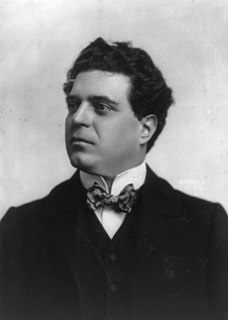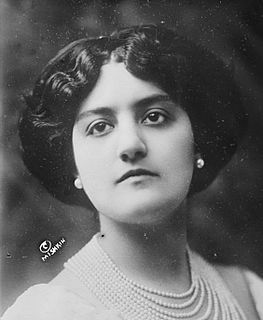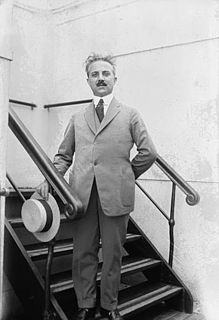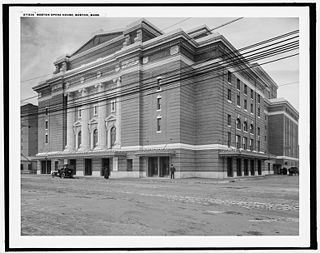
Pietro Mascagni was an Italian composer primarily known for his operas. His 1890 masterpiece Cavalleria rusticana caused one of the greatest sensations in opera history and single-handedly ushered in the Verismo movement in Italian dramatic music. While it was often held that Mascagni, like Ruggero Leoncavallo, was a "one-opera man" who could never repeat his first success, L'amico Fritz and Iris have remained in the repertoire in Europe since their premieres.
An impresario is a person who organizes and often finances concerts, plays, or operas, performing a role in stage arts that is similar to that of a film or television producer.

The Real Teatro di San Carlo, as originally named by the Bourbon monarchy but today known simply as the Teatro (di) San Carlo, is an opera house in Naples, Italy, connected to the Royal Palace and adjacent to the Piazza del Plebiscito. It is the oldest continuously active venue for opera in the world, having opened in 1737, decades before either Milan's La Scala or Venice's La Fenice.

Daly's Theatre was a theatre in the City of Westminster. It was located at 2 Cranbourn Street, just off Leicester Square. It opened on 27 June 1893, and was demolished in 1937.

Carmen Melis was an Italian operatic soprano who had a major international career during the first four decades of the 20th century. She was known, above all, as a verismo soprano, and was one of the most interesting singing actresses of the early 20th century. She made her debut in Novara in 1905 and her career rapidly developed in her native country over the next four years. From 1909 to 1916 she performed with important opera companies in the United States; after which she was busy performing at many of Europe's most important opera houses. From 1917 until her retirement from the stage in 1935 she was particularly active at the Teatro Costanzi in Rome and at La Scala in Milan. After her singing career ended, she embarked on a second career as a voice teacher. Her most notable student was soprano Renata Tebaldi.

Alice Nielsen was a Broadway performer and operatic soprano who had her own opera company and starred in several Victor Herbert operettas.
Gaetano Merola was an Italian conductor, pianist and founder of the San Francisco Opera.

Fortune Thomas Gallo was an Italian-born opera impresario. Gallo was owner and General Manager of the traveling San Carlo Opera Company from 1913 until its disbandment in the late 1950s.
The Chicago Opera Company was a grand opera company in Chicago, organized from the remaining assets of the bankrupt Chicago City Opera Company, that produced six seasons of opera at the Civic Opera House from 1940 to 1946. Artistic directors included Carlo Peroni (1941–1942) and Fausto Cleva (1944–1946), and until 1945 Fortune Gallo was general manager. After the war, when consumer goods became more abundant and people spent less money on entertainment, interest in opera collapsed and the company went bankrupt. Rather than try to re-organize, the remaining assets were given to the largest creditor, the landlord of the Civic Opera House, Household Finance, who then paid off the other remaining creditors. After the final collapse of an opera company that had been re-organized five times, there was no resident Chicago opera company until the founding of the Lyric Opera in 1954. One of the original group of organizers was Max Rabinoff.
The Los Angeles Civic Light Opera (LACLO) was an American theatre/opera company in Los Angeles, California. Founded under the motto "Light Opera in the Grand Opera manner" in 1938 by impresario Edwin Lester, the organization presented fifty seasons of theatre before closing due to financial reasons in 1987. Typically the LACLO presented four to six productions during an annual season. The company produced or co-produced several of their own shows in addition to bringing in shows from Broadway to California, often with their original casts. Productions that originated at the LACLO and then went on to wider success, included Song of Norway (1944), Magdalena (1948), Kismet (1953), Peter Pan (1954) and Gigi (1973). Initially the organization mainly presented American operettas, but by the 1960s the company was presenting mostly musical theatre; although the company never completely left its roots.

The Teatro San Benedetto was a theatre in Venice, particularly prominent in the operatic life of the city in the 18th and early 19th centuries. It saw the premieres of over 140 operas, including Rossini's L'italiana in Algeri, and was the theatre of choice for the presentation of opera seria until La Fenice was built in 1792.

Tarquinia Tarquini was an Italian dramatic soprano and the wife of composer Riccardo Zandonai.

The Boston Opera Company (BOC) was an American opera company located in Boston, Massachusetts, that was active from 1909 to 1915.
Henry Russell was an English impresario, conductor, director, and singing teacher.
Carlo Moresco was an American conductor, composer, violinist, and stage director of Italian birth. He was one of the most important opera conductors in the city of Philadelphia during the 20th century, working for multiple opera companies in that city. He also held conducting posts with companies in Connecticut and at the Tulsa Opera.

The Boston Opera House was an opera house located on Huntington Avenue in Boston, Massachusetts. It opened in 1909 as the home of the Boston Opera Company and was demolished in 1958 after years of disuse.
Carlo Peroni was an Italian opera conductor who served as the musical director of Fortune Gallo's San Carlo Opera Company (SCOC) from 1921 until his death 23 years later. With that company he performed in almost every major city in North America, typically conducting 8 opera performance a week eight months out of the year. In 1934, upon Peroni's 500th performance with the SCOC, The New York Times declared that he had conducted more grand opera performances in North America than any conductor in history.

Sofia Charlebois, also seen as Sophie Charlebois, Sophie Charlotte Wood, and from 1912 as Sofia Charlebois Gallo, was an American lyric soprano opera singer.

Mary Kaestner, also seen as Mary Kastner, was an opera singer, a dramatic soprano with the San Carlo Opera Company.

Grace Angelau was an American opera singer who had an active international career in operas and operettas in the 1920s, 1930s, and early 1940s. At various times in her career she was billed as a contralto and a soprano, but a 1942 article summarizing her career in Pix magazine labeled her as a mezzo-soprano. In the United States she appeared in operas in several theatres on Broadway, and was active with the touring San Carlo Opera Company, the Chicago Opera Company, and the New York Hippodrome Opera. She also appeared at European opera houses like La Scala, and at theaters in Australia, and Central and South America. She was particularly admired for her performances of Amneris in Giuseppe Verdi's Aida and Azucena in Verdi's Il trovatore. She owned and operated the Coonara Springs Restaurant & Gardens, now listed on the Victoria Heritage Database of historical sights, in Olinda, Victoria, Australia during the 1940s. Many of her costumes, jewelry, photographs, and other personal artifacts are part of the Australian Performing Arts Collection at the Arts Centre Melbourne.












